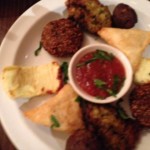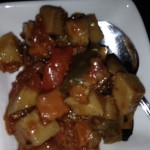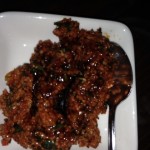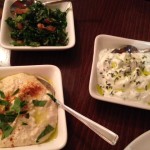How about this for a restaurant theme? An eatery decked out like and named “Stone Cave.” Maybe not the most persuasive or obvious way to attract the punters, but this Turkish joint, nestling among many more Turkish restaurants on Kingsland High Street in Dalston, East London, has evidently found it profitable these past 13 years. Actually the Turkish lanterns are a nice touch, but it is the food and service that probably earn plaudits and loyalty from local punters and pundits.
On our very brief visit, this being an urgent hunt for pre-theatre food inside 45 minutes, the service could barely have been more accommodating of our needs, even if it meant we had to forego the tempting kebabs and grills, not forgetting the entertainments on offer. In fact, we didn’t even bother with the menu, but headed straight for mixed hot and cold mezes for two, one Efe’s beer and one glass of wine.
Had we done so, we would have read that the maze consists of the following:
“Humus (sic), Kisir, Halloumi, Cacik, Saksuka, Falafel, Tabbouleh, Borek, Mucver, Mitte Kofte”
These days most Brits can translate a Chinese and India menu, but unless we are veterans of Greek, Turkish, Lebanese and/or other Middle-Eastern cuisine some of the names remain less familiar than the dishes they represent. However, where halloumi was pretty much unheard of in the UK when my ex-wife and I went to Cyprus on our honeymoon in 1990, it is now a staple and long since commoditised into supermarket stock. Kofte, hummus (as opposed to “humus“), falafel, tabbouleh and even börek are common currents too. However, for the initiated:
- Cacik = “Cucumber and a hint of garlic in creamy yogurt sauce topped with dry mint” – a close relative of raita, in other words.
- Kisir = “Cracked wheat, parsley, spring onion,cucumber, lemon juice and olive oil with herbs” – which sounds identical to tabbouleh to me, though here the latter is described as “a refreshing parsley salad with mint, bulgur, tomato & onion.”
- Saksuka = “Aubergine, Tomatoes, Potatoes, Red & Green peppers with tomato sauce.”
- Mucver = “Crispy courgette fritters served with mint yoghurt.”
Nomenclature may vary across the region, but dishes are remarkably similar across national boundaries. The unifying factor is simple – they are uniformly delicious. So it proved here, even allowing for the slightly flattened felafel proving a tad dry and overcooked. The welter of dishes tasted fresh, vibrant and perfect for the occasion. At £12.95 for a plateful fit for two, they impressed greatly – and surprisingly compensated for all other tummy rumblings for the remainder of the evening (wine notwithstanding.)
Had we had time to complete a full dinner, I’d have been temped by “ISKENDER YAYLA KEBAB £ 13.95” – in part because I am intrigued by the idea of lamb, chicken and Adana kebabs. Adana is a city and province in southern Turkey, but also the generic name for a minced lamb kebab, not dissimilar to the familiar Pakistani and Bangladeshi Seekh kebab, and many others with which we are all familiar. In turn, this reminds me of Hamburger doubling up as the name of residents from a German city.
I have no doubt the dish would have been tasty and succulent, but then that is a good reason for buying a meal in an area where competition is stiff and prices keen – just as Brick Lane and Chinatown will buy you excellent dinners. This area of East London is “little Turkey,” and very definitely worth a try if you are passing.









